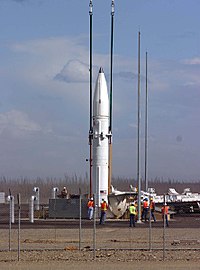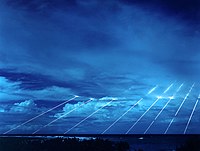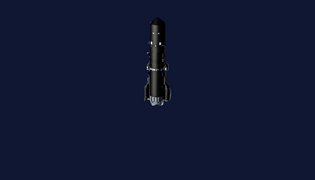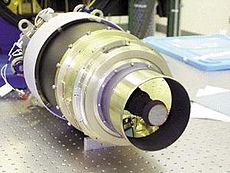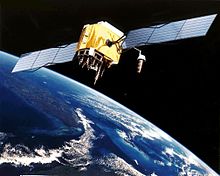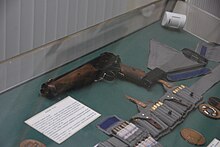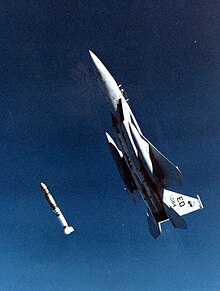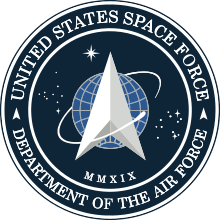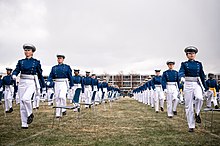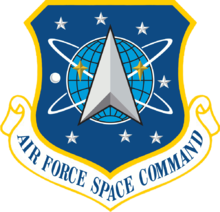A Ground-Based Interceptor, designed to destroy incoming Intercontinental ballistic missiles, is lowered into its silo at the missile defence complex at Fort Greely, Alaska, July 22, 2004.
The militarisation of space involves the placement and development of weaponry and military technology in outer space. The early exploration of space in the mid-20th century had, in part, a military motivation, as the United States and the Soviet Union used it as an opportunity to demonstrate ballistic-missile
technology and other technologies having the potential for military
application. Outer space has since been used as an operating location
for military spacecraft such as imaging and communications satellites, and some ballistic missiles pass through outer space during their flight. As of 2019, known deployments of weapons stationed in space include only the Almaz space-station armament and pistols such as the TP-82 Cosmonaut survival pistol (for post-landing, pre-recovery use).
History
The Cold War
During the Cold War, the world's two great superpowers—the Soviet Union and the United States of America—spent large proportions of their GDP on developing military technologies. The drive to place objects in orbit stimulated space research and started the Space Race. In 1957, the USSR launched the first artificial satellite, Sputnik 1.
By the end of the 1960s, both countries regularly deployed satellites. Reconnaissance satellites
were used by militaries to take accurate pictures of their rivals'
military installations. As time passed the resolution and accuracy of
orbital reconnaissance alarmed both sides of the iron curtain. Both the United States and the Soviet Union began to develop anti-satellite weapons to blind or destroy each other's satellites. Directed-energy weapons, kamikaze-style
satellites, as well as orbital nuclear explosives were researched with
varying levels of success. Spy satellites were, and continue to be,
used to monitor the dismantling of military assets in accordance with
arms control treaties signed between the two superpowers. To use spy
satellites in such a manner is often referred to in treaties as
"national technical means of verification".
The superpowers developed ballistic missiles to enable them to use nuclear weaponry across great distances. As rocket science developed, the range of missiles increased and intercontinental ballistic missiles
(ICBM) were created, which could strike virtually any target on Earth
in a timeframe measured in minutes rather than hours or days. To cover
large distances ballistic missiles are usually launched into sub-orbital spaceflight.
Test of the LG-118A Peacekeeper missile, each one of which could carry 10 independently targeted nuclear warheads along trajectories outside of the Earth's atmosphere.
As soon as intercontinental missiles were developed, military
planners began programmes and strategies to counter their effectiveness.
United States
Early American efforts included the Nike-Zeus Program, Project Defender, the Sentinel Program and the Safeguard Program.
The late 1950s Nike-Zeus programme involved firing Nike nuclear
missiles against oncoming ICBMs, thus exploding nuclear warheads over
the North Pole. This idea was soon scrapped and work began on Project
Defender in 1958.
Project Defender attempted to destroy Soviet ICBMs at launch with
satellite weapon systems, which orbited over Russia. This programme
proved infeasible with the technology from that era. Work then began on the Sentinel Program which used anti-ballistic missiles (ABM) to shoot down incoming ICBMs.
In the late 1950s United States Air Force considered detonating an atomic bomb on the Moon to display U.S. superiority to the Soviet Union and the rest of the world (Project A119). In 1959, a feasibility study of a possible military base on the Moon (Project Horizon) was conducted. In 1958, a plan for a 21-airman underground Air Force base on the Moon by 1968 was developed (Lunex Project).
The Safeguard Program
was deployed in the mid-1970s and was based on the Sentinel Program.
Since the ABM treaty only allowed for construction of a single ABM
facility to protect either the nation's capital city or an ICBM field,
the Stanley R. Mickelsen Safeguard Complex was constructed near Nekoma, North Dakota to protect the Grand Forks ICBM facility.
Though it was only operational as an ABM facility for less than a
year, the Perimeter Acquisition Radar (PAR), one of Safeguard's
components, was still operational as of 2005. One major problem with
the Safeguard Program, and past ABM systems, was that the interceptor
missiles, though state-of-the-art, required nuclear warheads to destroy
incoming ICBMs. Future ABMs will likely be more accurate and use hit-to-kill
or conventional warheads to knock down incoming warheads. The
technology involved in such systems was shaky at best, and deployment
was limited by the ABM treaty of 1972.
In 1983, American president Ronald Reagan proposed the Strategic Defense Initiative
(SDI), a space-based system to protect the United States from attack by
strategic nuclear missiles. The plan was ridiculed by some as
unrealistic and expensive, and Dr Carol Rosin nicknamed the policy "Star
Wars", after the popular science-fiction movie franchise. Astronomer Carl Sagan
pointed out that in order to defeat SDI, the Soviet Union had only to
build more missiles, allowing them to overcome the defence by sheer
force of numbers. Proponents of SDI said the strategy of technology
would hasten the Soviet Union's downfall. According to this doctrine,
Communist leaders were forced to either shift large portions of their
GDP to counter SDI, or else watch as their expensive nuclear stockpiles
were rendered obsolete.
United States Space Command (USSPACECOM), a unified command of the United States military, was created in 1985 to help institutionalise the use of outer space by the United States Armed Forces. The Commander in Chief of U.S. Space Command (CINCUSSPACECOM), with headquarters at Peterson Air Force Base, Colorado was also the Commander in Chief of the bi-national U.S.-Canadian North American Aerospace Defense Command (CINCNORAD), and for the majority of time during USSPACECOM's existence also the Commander of the U.S. Air Force major command Air Force Space Command. Military space operations coordinated by USSPACECOM proved to be very valuable for the U.S.-led coalition in the 1991 Persian Gulf War.
The U.S. military has relied on communications, intelligence,
navigation, missile warning and weather satellite systems in areas of
conflict since the early 1990s, including the Balkans, Southwest Asia
and Afghanistan. Space systems are considered indispensable providers
of tactical information to U.S. war-fighters.
As part of the ongoing initiative to transform the U.S. military, on 26 June 2002, Secretary of Defense Donald Rumsfeld announced that U.S. Space Command would merge with USSTRATCOM. The UCP directed that Unified Combatant Commands be capped at ten, and with the formation of the new United States Northern Command, one would have to be deactivated in order to maintain that level. Thus the USSPACECOM merger into USSTRATCOM.
USSR
Polyus (1987).
The Soviet Union was also researching innovative ways of gaining space supremacy. Two of their most notable efforts were the R-36ORB Fractional Orbital Bombardment System (FOBS) and Polyus orbital weapons system.
The R-36ORB was a Soviet ICBM in the 1960s that, once launched, would go into a low Earth orbit whereupon it would de-orbit for an attack. This system would approach North America over the South Pole, thereby striking targets from the opposite direction from that to which NORAD early warning systems are oriented. The missile was phased out in January 1983 in compliance with the SALT II treaty.
The SALT II treaty (1979) prohibited the deployment of FOBS systems:
- Each Party undertakes not to develop, test, or deploy:
- (...)
- (c) systems for placing into Earth orbit nuclear weapons or any other kind of weapons of mass destruction, including fractional orbital missiles;
On May 15, 1987, an Energia rocket flew for the first time. The payload was a prototype orbital weapons platform Polyus
(also known as Polus, Skif-DM or 17F19DM), the final version of which
according to some reports could be armed with nuclear space mines and
defensive cannon. The Polyus weapons platform was designed to defend
itself against anti-satellite weapons with recoilless cannon. It was
also equipped with a sensor blinding laser to confuse approaching
weapons and could launch test targets to validate the fire control
system. The attempt to place the satellite into orbit failed.
Post-Cold War
A Lightweight Exo-Atmospheric Projectile (LEAP), which attaches to a modified SM-2 Block IV missile used by the U.S. Navy
As the Cold War ended with the implosion of the Soviet Union the
space race between the two superpowers ended. The United States of
America was left as the only superpower on Earth with a large
concentration of the world's wealth and technological advancement.
Despite the United States' new status in the world, the monopoly of
space militarisation is in no way certain. Countries such as China, Japan, and India have begun their own space programmes, while the European Union collectively works to create satellite systems to rival those of the United States.
The USSR Space Forces were established as the Ministry of Defense
Space Units in 1982. In 1991 the Soviet Union disintegrated. The Russian Armed Forces were established on 7 May 1992, enabling the creation of Russian Space Forces later that year on 10 August. In July 1997 the Space Force was dissolved as a separate service arm and incorporated to the Strategic Rocket Forces along with the Space Missile Defense Forces, which previously were part of the Troops of Air Defense. The Russian Space Forces were officially reborn on June 1, 2001 as an independent section of the Russian military.
Post Cold War space militarisation seems to revolve around three
types of applications. (The word "seems" is used because much of this
subject matter is inconclusively verifiable, due to the high level of
secrecy that exists among the great powers
with regard to the details of space sensing systems.) The first
application is the continuing development of "spy" or reconnaissance
satellites which began in the Cold War era, but has progressed
significantly since that time. Spy satellites perform a variety of
missions such as high-resolution photography (IMINT) and communications eavesdropping (SIGINT).
These tasks are performed on a regular basis both during peacetime and
war operations. Satellites are also used by the nuclear states to
provide early warning of missile launches, locate nuclear detonations,
and detect preparations for otherwise clandestine or surprise nuclear
tests (at least those tests or preparations carried out above-ground);
this was the case when, in 1998, India and Pakistan both conducted a series of nuclear tests; in addition, a nuclear-detection satellite of the Vela type was also reported to have detected a nuclear detonation in the Indian Ocean in 1978 that was believed to be a South African nuclear test in what was famously called the Vela Incident. Early-warning satellites can also be used to detect tactical missile launches; this capability was used during Desert Storm, when America was able to provide advance warning to Israel of Iraqi SS-1 SCUD missile launches.
Military satellite
Launch of the first Skynet satellite
Types of Reconnaissance satellites
 United States
United States
 Soviet Union
Soviet Union
 United Kingdom
United Kingdom
 France
France
 Germany
Germany
 Italy
Italy
 Japan
Japan
 People's Republic of China
People's Republic of China
 India
India
 Israel
Israel
- Ofeq series of photo reconnaissance and radar satellites
 Spain
Spain
Global Positioning System (GPS)
Artist's conception of a Global Positioning System satellite in Earth orbit.
The second application of space militarisation currently in use is GPS or Global Positioning System. This satellite navigation system is used for determining one's precise location and providing a highly accurate time reference almost anywhere on Earth or in Earth orbit. It uses an intermediate circular orbit (ICO) satellite constellation of at least 24 satellites. The GPS system was designed by and is controlled by the United States Department of Defense
and can be used by anyone, free of charge. The cost of maintaining the
system is approximately US$400 million per year, including the
replacement of ageing satellites. The first of 24 satellites that form
the current GPS constellation (Block II) was placed into orbit on
February 14, 1989. The 52nd GPS satellite since the beginning in 1978
was launched November 6, 2004 aboard a Delta II
rocket.
The primary military purposes are to allow improved command and control
of forces through improved location awareness, and to facilitate
accurate targeting of smart bombs, cruise missiles, or other munitions. The satellites also carry nuclear detonation detectors, which form a major portion of the United States Nuclear Detonation Detection System. European concern about the level of control over the GPS network and commercial issues has resulted in the planned Galileo positioning system. Russia already operates an independent system called GLONASS
(global navigation system); the system operates with 24 satellites that
are deployed in 3 orbital planes as opposed to the 4 in which GPS is
deployed.
The Chinese "Beidou" system provides China a similar regional (not global) navigation capability.
Military communication systems
The third current application of militarisation of space can be demonstrated by the emerging military doctrine of network-centric warfare.
Network-centric warfare relies heavily on the use of high-speed
communications, which allows all soldiers and branches of the military
to view the battlefield in real-time. Real-time technology improves the
situational awareness of all of the military's assets and commanders in a given theatre. For example, a soldier in the battle zone can access satellite imagery of enemy positions two blocks away, and if necessary e-mail the coordinates to a bomber or weapon platform
hovering overhead while the commander, hundreds of miles away, watches
as the events unfold on a monitor. This high-speed communication is
facilitated by a separate internet created by the military for the military.
Communication satellites hold this system together by creating an
informational grid over the given theatre of operations. The Department of Defense is currently working to establish a Global Information Grid
to connect all military units and branches into a computerised network
in order to share information and create a more efficient military.
Military spaceplanes
It was revealed that Soviet officials were concerned that the US Space Shuttle program had such military objectives such as to make a sudden dive into the atmosphere to drop bombs on Moscow and these concerns were part of the motivation behind pursuing their own Buran programme.
The NASA uncrewed spaceplane project X-37
was transferred to the US Department of Defense in 2004. It is unclear
what its military mission would be. The X-37 is akin to a space version
of Unmanned aerial vehicle.
Weapons in space
Triple-barreled TP-82 Cosmonaut survival pistol in Saint-Petersburg Artillery museum
Space weapons are weapons used in space warfare. They include weapons that can attack space systems in orbit (i.e. anti-satellite weapons),
attack targets on the earth from space or disable missiles travelling
through space. In the course of the militarisation of space, such
weapons were developed mainly by the contesting superpowers during the Cold War, and some remain under development today. Space weapons are also a central theme in military science fiction and sci-fi video games.
Terrestrial-type weapons in space
The Soviet space station Salyut 3
was fitted with a 23mm cannon, which was successfully test fired at
target satellites, at ranges from 500 to 3,000 metres (1,600 to
9,800 ft).
As of 2008, it was reported that Russian cosmonauts have regularly carried the TP-82 Cosmonaut survival pistol
on Soyuz spacecraft, as part of the emergency landing survival kit. The
intent of the weapon is to protect cosmonauts from wild animals in the
event of an off-course wilderness landing. The specially designed gun is
capable of firing bullets, shotgun shells, or flares.
Space warfare
Space warfare is combat that takes place in outer space, i.e. outside the atmosphere. Technically, as a distinct classification, it refers to battles where the targets themselves are in space. Space warfare therefore includes ground-to-space warfare, such as attacking satellites from the Earth, as well as space-to-space warfare, such as satellites attacking satellites.
It does not include the use of satellites for espionage, surveillance, or military communications, however useful those activities might be. It does not technically include space-to-ground warfare,
where orbital objects attack ground, sea or air targets directly, but
the public and media frequently use the term to include any conflict
which includes space as a theatre of operations, regardless of the
intended target. For example, a rapid delivery system in which troops
are deployed from orbit might be described as "space warfare," even
though the military uses the term as described above.
A film was produced by the U.S. Military in the early 1960s called Space and National Security which depicted space warfare.[9] From 1985 to 2002 there was a United States Space Command, which in 2002 merged with the United States Strategic Command. There is a Russian Space Force, which was established on August 10, 1992, and which became an independent section of the Russian military on December 1, 2001.
Only a few incidents of space warfare have occurred in world
history, and all were training missions, as opposed to actions against
real opposing forces. In the mid-1980s a USAF pilot in an F-15 successfully shot down the P78-1, a communications satellite in a 345-mile (555 km) orbit.
In 2007 the People's Republic of China used a missile system to destroy one of its obsolete satellites , in 2008 the United States similarly destroyed its malfunctioning satellite USA 193, and in 2019, India followed China and the U.S. by destroying a live satellite.
To date, there have been no human casualties resulting from conflict in
space, nor has any ground target been successfully neutralised from
orbit.
International treaties governing space limit or regulate
conflicts in space and limit the installation of weapon systems,
especially nuclear weapons.
Space treaties
Treaties are agreed to when all parties perceive a benefit from becoming a signatory participant in the treaty. As mutually assured destruction
(MAD) became the deterrent strategy between the two superpowers in the
Cold War, many countries worked together to avoid extending the threat
of nuclear weapons to space based launchers.
Outer Space Treaty
The Outer Space Treaty was considered by the Legal Subcommittee in 1966. Later that year, agreement was reached in the United Nations General Assembly. The treaty included the following principles:
- the exploration and use of outer space shall be carried out for the benefit and in the interests of all countries and shall be the province of all mankind;
- outer space shall be free for exploration and use by all States;
- outer space is not subject to national appropriation by claim of sovereignty, by means of use or occupation, or by any other means;
- States shall not place nuclear weapons or other weapons of mass destruction in orbit or on celestial bodies or station them in outer space in any other manner;
- the Moon and other celestial bodies shall be used exclusively for peaceful purposes;
- Astronauts shall be regarded as the envoys of mankind;
- States shall be responsible for national space activities whether carried out by governmental or non-governmental activities;
- States shall be liable for damage caused by their space objects; and
- States shall avoid harmful contamination of space and celestial bodies.
In summary, the treaty initiated the banning of signatories' placing of nuclear weapons or any other weapons of mass destruction in orbit of Earth, installing them on the moon or any other celestial body, or to otherwise station them in outer space. The United States, the United Kingdom,
and the Soviet Union signed the treaty and it entered into effect on
October 10, 1967. As of January 1, 2005, 98 States have ratified, and an
additional 27 have signed the Outer Space Treaty.
Note that this treaty does not ban the placement of weapons in space in general, only nuclear weapons and WMD.
Moon Treaty
The Moon Treaty (not ratified by any space capable state, though
signed by some) bans any military use of celestial bodies, including
weapon testing, nuclear weapons in orbit, or military bases. The use of
military personnel for scientific research or for any other peaceful
purposes shall not be prohibited. (Article 3.4)
Other drafts
In February 2008, China and Russia together submitted a draft to the UN known as the Treaty on Prevention of the Placement of Weapons in Outer Space and of the Threat or Use of Force against Outer Space Objects (PPWT).
The US opposed the draft treaty due to security concerns over its space
assets despite the treaty explicitly affirming a State's inherent right
of self-defence. On December 4, 2014, the General Assembly of the UN passed two resolutions on preventing an arms race in outer space.[15]
The first resolution, Prevention of an arms race in outer space,
"call[s] on all States, in particular those with major space
capabilities, to contribute actively to the peaceful use of outer space,
prevent an arms race there, and refrain from actions contrary to that
objective." There were 178 countries that voted in favour to none against, with 2 abstentions (Israel, United States).
The second resolution, No first placement of weapons in outer space,
emphasises the prevention of an arms race in space and states that
"other measures could contribute to ensuring that weapons were not
placed in outer space."
126 countries voted in favour to 4 against (Georgia, Israel, Ukraine,
United States), with 46 abstentions (EU member States abstained on the
resolution).
National Missile Defense (NMD)
With the fall of the Soviet Union and the end of the Cold War defence
spending was reduced and space research was chiefly focused on peaceful
research. American military research is focused on a more modest goal
of preventing the United States from being subject to nuclear blackmail or nuclear terrorism by a rogue state.
On 16 December 2002, US President George W. Bush
signed National Security Presidential Directive which outlined a plan
to begin deployment of operational ballistic missile defence systems by
2004. The following day, the US formally requested from the UK and Denmark use of facilities in RAF Fylingdales, England and Thule, Greenland, respectively, as a part of the NMD Program.
The administration continued to push the programme, despite highly
publicised but not unexpected trial-and-error technical failures during
development and over the objections of some scientists who opposed it.
The projected cost of the programme for the years 2004 to 2009 was 53
billion US dollars, making it the largest single line in The Pentagon's budget.
Missile defence does not station weapons in space, but is
designed to intercept incoming warheads at a very high altitude, which
requires the interceptor to travel into space to achieve the intercept.
These missiles are both land-based and sea-based.
